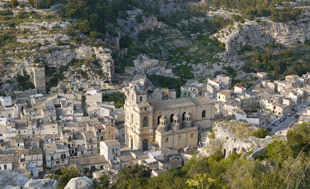Scicli (pronounced sheek-ly) is one of the UNESCO-listed Baroque towns of south-east Sicily, but it is rather off-the-beaten-track compared with its more visited neighbours Noto, Ragusa and Modica. This overlooked town has a scenic location and charm that at least matches its rivals, though, along with an enjoyable sense of discovery for the visitors who explore its streets. It does have an up-and-coming feel about it, so future visitors may find more tourist development, though hopefully that will not detract from its pleasant aura of exclusivity.
- Sicily destinations and practicalities: full menu (at foot of this page)
Scicli shares its architectural heritage with other towns in the area, but it also has some unique attractions of its own, including a neatly-kept centre, fine clean stonework, and a dramatic situation in a basin overhung by churches and monasteries on high crags.
Scicli is one of the filming locations for popular Sicilian detective drama Il Commissario Montalbano, which is exported to several other countries, and viewers will enjoy spotting familiar scenes.
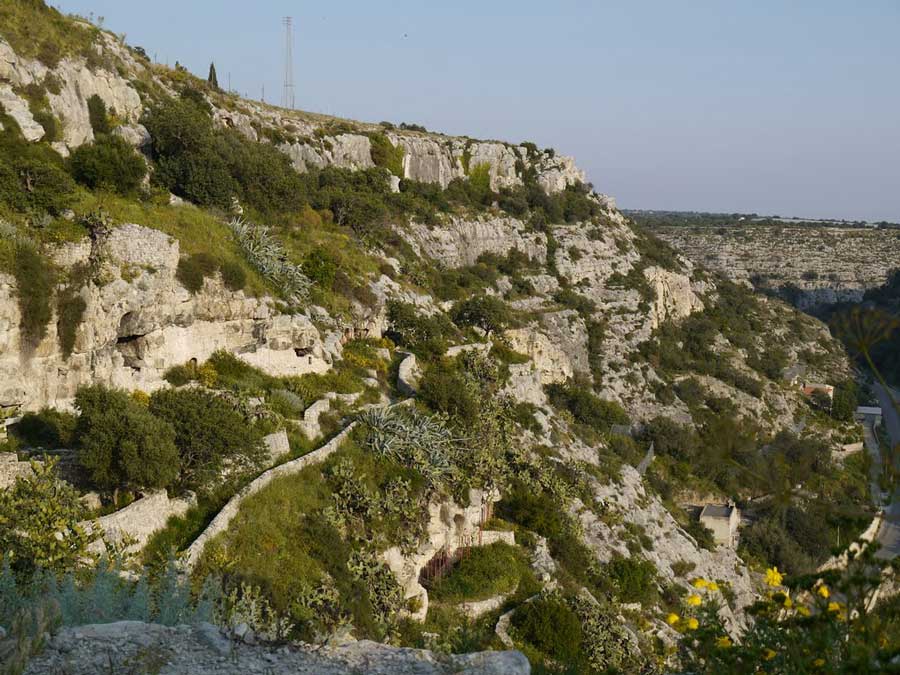
About Scicli
Scicli is an ancient town, which grew up around two valleys divided by steep ridges, emerging onto a wider vale. Early settlements were up on the ridges – the town’s principal church, San Matteo, sat on a commanding position overlooking the smaller valleys as they opened into a wider vale. Around the church, on the slopes, were clustered cave-dwellings. Over time, as the defensive functions of the site grew less important, the town shifted down the hillside and nowadays the inhabited area fills the wide level vale like a grey flood of buildings below the old church on its headland. By the 1950s the final residents of the cave-settlement were rehoused in social housing at the far end of town, and the upper slopes were abandoned, along with San Matteo.
Some of Scicli’s history may sound familiar to those who’ve visited Italy’s most famous cave-dwelling site, Matera in Basilicata. Scicli has some of the same appeal – but without the effective, sensitive redevelopment which has made Matera a tourist attraction. Here in Scicli, the caves still lie overgrown. Down by the road, a partially done-up cave with a front door and windows had a fading ‘for sale’ sign in the window. At the time we visited, attempts to develop the cave-dwelling area as an archaeological site seemed to have stalled. This is a town ripe for discovery and investment… though its Sicilian location may be hampering progress.
In the meantime, Scicli can offer not just the elegance of its Baroque buildings, built after the 1693 earthquake which devastated the area, but also the thrill of discovery, as visitors uncover the town’s various charms.
The heart of Scicli, and the part of interest to tourists, still lies around the foot of the dramatic ridge dominated by the church of San Matteo, though the church, like the cave houses, now lies abandoned. On either side of the ridge lie the valleys of Santa Maria la Nova and San Bartolomeo, each containing the grand churches for which they are named. Beyond these valleys are other steep ridges crowned with religious complexes. Directly in front of San Matteo are the main streets and squares of the town.
Piazza Italia is the business-like heart of Scicli; a long square lined with (mostly) elegant palaces, with cars cruising by, locals stopping to chat and old men trading information and fresh produce. A pedestrianised strip runs down the centre of the square, where there are benches and a childrens’ playground, and intercity buses stop at the bottom.
But for a pleasant stroll, or a lazy drink in the sunshine, the most charming spot is Via Penna, an elegant pedestrianised street lined with Baroque palaces and churches. At the wide eastern end there are bars with tables outside, where you can watch the comings and goings at the town hall (mostly bored-looking men gazing out the windows while businesslike ladies clip-clop in and out) and townsfolk and visitors strolling by.
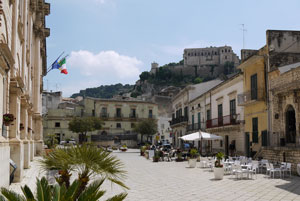
Scicli’s most striking Baroque palace is Palazzo Beneventano, on Via Duca d’Aosta, close to Piazza Italia and Via Penna . This is a grand show-off of a building, featuring leering faces, monstrous beasts and other architectural fantasies, partly eroded away.
The lane to the right of the palazzo leads to a zig-zag path ascending the hill above town. The short walk leads past ancient, new, ruined and restored buildings, past remarkable views of gorges and caves in the cliffs beyond the valley, before emerging onto a terrace by Scicli’s former’mother church’ San Matteo, standing sad and abandoned. From the terrace there are great views over Scicli, which show how the town filled its original valleys, and spilled down through the whole wider vale and beyond. A path behind the church continues up the ridge, passing turn-offs to a watchtower, crumbling with flowers growing from the ruins and an old tiled terrace, and to the church of Santo Spirito, a simple but elegant building where, peering though a gap in the locked door, we saw in the far corner a passageway leading down into the rock.
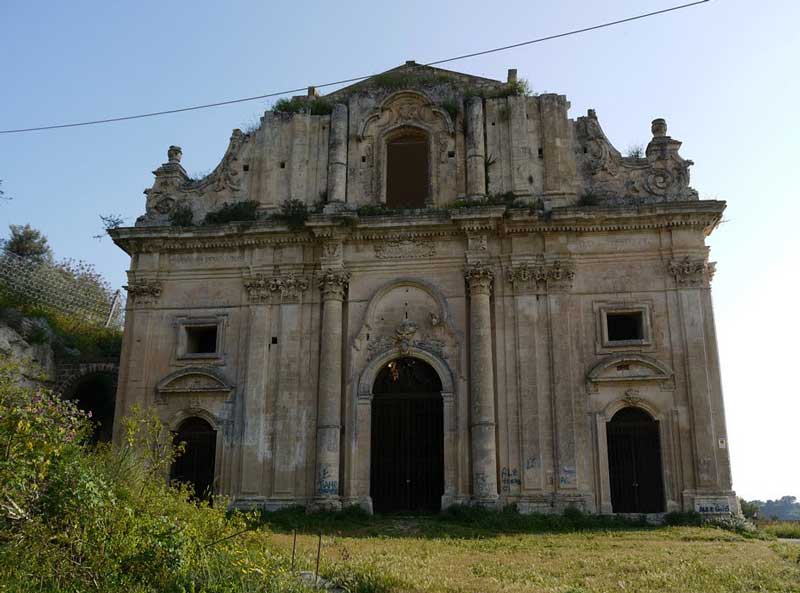
One of the oldest districts of Scicli, the abandoned cave settlement of Chiafura lies on the slopes of this ridge, accessible from a path close to the ruined fort. When we visited this footpath was overgrown, though a noticeboard proclaimed that EU funds had been spent on establishing a percorso archeologico, an archaeological route. The relevant monies having evidently vanished, attempts to maintain the path had been abandoned. Since this is such an obvious heritage attraction, perhaps future visitors will find improvements. From the ridge, winding green walled paths lead down and along the craggy slope, lined with cave dwellings; some mere entrances and others built outwards into semi-cottages, a couple of which were heavily restored. Although too overgrown for easy exploration when we visited, it Would be lovely to tour this area if it were slightly better-kept. Another access path, signposted, at the foot of the slope, in the San Bartolomeo valley, shows where some of the EU money went: a stairlift and big locked gates to bar access.
Returning back down the main path from San Matteo, explorers can take a left turn onto a contouring lane to pass the entrance of a cave church, Santa Maria della Catena. This church (kept closed), with old doors once painted decoratively, now faded, was built right into the hill, with a doorway straight into the rock face.
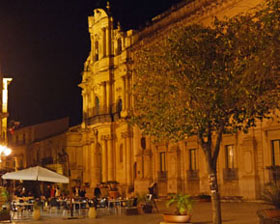
In the lower part of the Chiafura area, among the dwellings in the San Bartolomeo valley, is a ‘show cave’ open by appointment; contact information available on website ‘A rutta ri Ron Carmelu’ (see links panel) and outside the entrance. There is also a costume museum in Scicli, on Via Penna, and a museum dedicated to local cuisine (Museo della Cucina Iblea) situated on Via Spadara. Both have limited opening times.
The other sights of Scicli are less striking but still pleasant. There are plenty of picturesque spots along the valleys and up the slopes of the old part of town, where washing hangs out to dry, children play, and grand abandoned palaces rot away alongside carefully-maintained residences. In the heart of town, one of the architectural highlights on the elegant Via Penna is the Chiesa di San Michele Arcangelo, one of Scicli’s fine eighteenth-century churches, with its charmingly painted interior featuring musical instrument motifs.
Scicli repays time spent exploring with fine palazzi, fantastical Baroque balconies, picturesque lanes with washing hanging out to dry, plenty of different, impressive views of churches on crags and mysterious cave-mouths, and simple scenes of everyday Sicilian life. It is easy to see the best of Scicli in a couple of hours, but this is a great place to spend longer, to amble and see the sights at your leisure, and to absorb the slow-paced, sun-soaked atmosphere of provincial Sicily.
Hopefully future development can open up some more of the oldest cave-settlement, as well as making more of the picturesque lanes, decrepit houses, and isolated caves up the valley slopes. The town of Matera in Basilicata give an example of what can be done with such a rich heritage.

Food and drink
The ‘tourist’ part of Scicli doesn’t have a great deal of choice for food at the time of writing, but there are several bars for drinks, snacks and light meals around Piazza Italia, Via Nazionale and on Via Penna – a great place to sit at an outdoor table with a glass of almond milk (latte di mandorla). Scicli’s most atmospheric place to eat must be La Grotta, a restaurant in a cave on Via Dolomiti. At outdoor tables and in its rock-cut interior (see photograph), La Grotta serves good, filling Sicilian food – pizzas, pasta, seafood and meat dishes – to locals and visitors. Up a little lane close to Via Penna, Al Barocco is an unpretentious restaurant-pizzeria (pizzas only in the evenings) that makes another convenient place to eat in the centre of town.
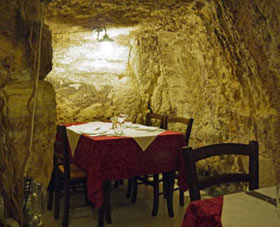
Scicli travel and transport
Scicli is well-connected by bus and train with the other towns in this area, and it is easy to combine in a tour with more well-known destinations like Noto, Ragusa, Modica and Siracusa.
The small railway station is south of the town centre, at the end of Corso Mazzini. It’s an easy walk to the town centre; just head straight along Corso Mazzini for ten-fifteen minutes. Scicli is on a regional line between Siracusa and Ragusa, with just a few small trains stopping here. There were no obvious station facilities when we visited – if you are unable to purchase tickets onsite or from a nearby bar or tabacchi shop, speak to the conductor when you board the train.
Buses stop by a roundabout where Corso Mazzini intersects with Largo Gramsci, at the lower end of Piazza Italia. Bus tickets can be bought at the bar opposite. A firm called AST operates many bus services in this area. Among their routes is a bus connecting Scicli with Catania Airport several times a day; a journey of around two and half hours. A bus to Modica takes around 40 minutes.
Around Scicli
Scicli is in easy reach of other interesting holiday destinations including the other Baroque towns: Noto, Modica and Ragusa, which is 15 miles away. Any of these could be visited as a day trip, using public transport or driving – though I’d recommend staying overnight in charming Ragusa. Scicli is close to the sea, and trips to the coast would add variety to a stay in Scicli. Local seaside destinations include Donnalucata, a fishing settlement, Punta Secca, home of Commissario Montalbano in the TV series of the same name, and Sampieri, dominated by the tall outline of a ruined brickworks which will also be familiar to viewers of the detective drama. If you have a car, Scicli would make a pleasant base for several nights. Otherwise your options are more limited, but it is still a pleasant place to unwind, explore, enjoy some sunshine – with the advantage of exceptionally good accommodation options. I’d definitely recommend including Scicli in a tour of this part of Sicily.
Scicli accommodation
Hotels and B&Bs
There are more places to stay in Scicli these days, as it becomes more of a ‘discovered’ gem, but I’d still advise visitors to book well ahead. One of the best places to stay in Scicli is the Boutique Hotel Borgo Hedone, an elegant restored historic palazzo in a wonderful setting. B&B Casa di Pam offers a cheaper B&B alternative. For fans of the ‘scattered hotel’ concept, Albergo Diffuso Scicli offers rooms around the historic centre, with breakfast taken in the main hotel building.
> Find accommodation in and around Scicli
![]()
Highlights
Useful external links
A rutta ri Ron Carmelu – museum cave
Museo del Costume – Museum of Costume and Traditions
